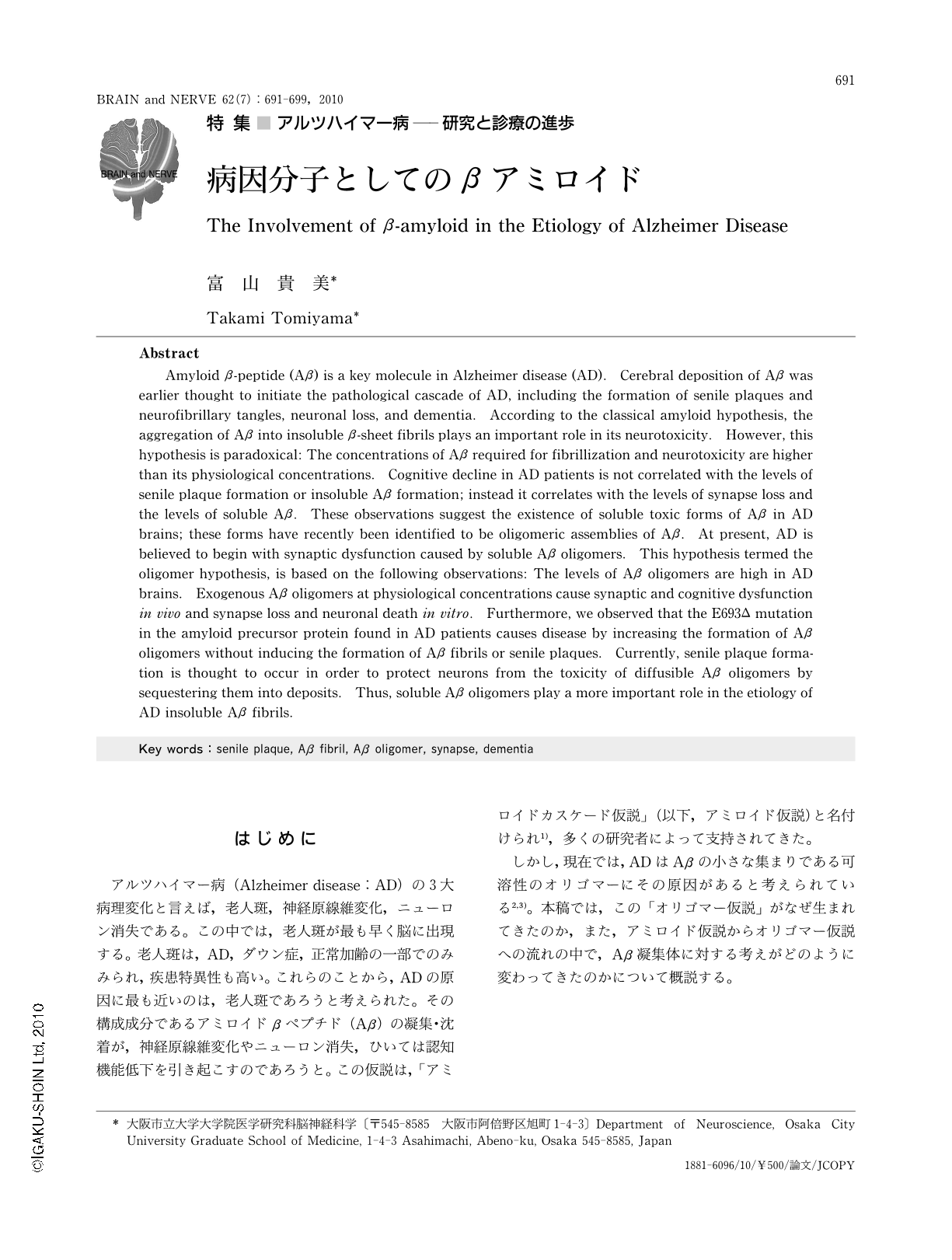Japanese
English
- 有料閲覧
- Abstract 文献概要
- 1ページ目 Look Inside
- 参考文献 Reference
はじめに
アルツハイマー病(Alzheimer disease:AD)の3大病理変化と言えば,老人斑,神経原線維変化,ニューロン消失である。この中では,老人斑が最も早く脳に出現する。老人斑は,AD,ダウン症,正常加齢の一部でのみみられ,疾患特異性も高い。これらのことから,ADの原因に最も近いのは,老人斑であろうと考えられた。その構成成分であるアミロイドβペプチド(Aβ)の凝集・沈着が,神経原線維変化やニューロン消失,ひいては認知機能低下を引き起こすのであろうと。この仮説は,「アミロイドカスケード仮説」(以下,アミロイド仮説)と名付けられ1),多くの研究者によって支持されてきた。
しかし,現在では,ADはAβの小さな集まりである可溶性のオリゴマーにその原因があると考えられている2,3)。本稿では,この「オリゴマー仮説」がなぜ生まれてきたのか,また,アミロイド仮説からオリゴマー仮説への流れの中で,Aβ凝集体に対する考えがどのように変わってきたのかについて概説する。
Abstract
Amyloid β-peptide (Aβ) is a key molecule in Alzheimer disease (AD). Cerebral deposition of Aβ was earlier thought to initiate the pathological cascade of AD,including the formation of senile plaques and neurofibrillary tangles,neuronal loss,and dementia. According to the classical amyloid hypothesis,the aggregation of Aβ into insoluble β-sheet fibrils plays an important role in its neurotoxicity. However,this hypothesis is paradoxical: The concentrations of Aβ required for fibrillization and neurotoxicity are higher than its physiological concentrations. Cognitive decline in AD patients is not correlated with the levels of senile plaque formation or insoluble Aβ formation; instead it correlates with the levels of synapse loss and the levels of soluble Aβ. These observations suggest the existence of soluble toxic forms of Aβ in AD brains; these forms have recently been identified to be oligomeric assemblies of Aβ. At present,AD is believed to begin with synaptic dysfunction caused by soluble Aβ oligomers. This hypothesis termed the oligomer hypothesis,is based on the following observations: The levels of Aβ oligomers are high in AD brains. Exogenous Aβ oligomers at physiological concentrations cause synaptic and cognitive dysfunction in vivo and synapse loss and neuronal death in vitro. Furthermore,we observed that the E693Δ mutation in the amyloid precursor protein found in AD patients causes disease by increasing the formation of Aβ oligomers without inducing the formation of Aβ fibrils or senile plaques. Currently,senile plaque formation is thought to occur in order to protect neurons from the toxicity of diffusible Aβ oligomers by sequestering them into deposits. Thus,soluble Aβ oligomers play a more important role in the etiology of AD insoluble Aβ fibrils.

Copyright © 2010, Igaku-Shoin Ltd. All rights reserved.


